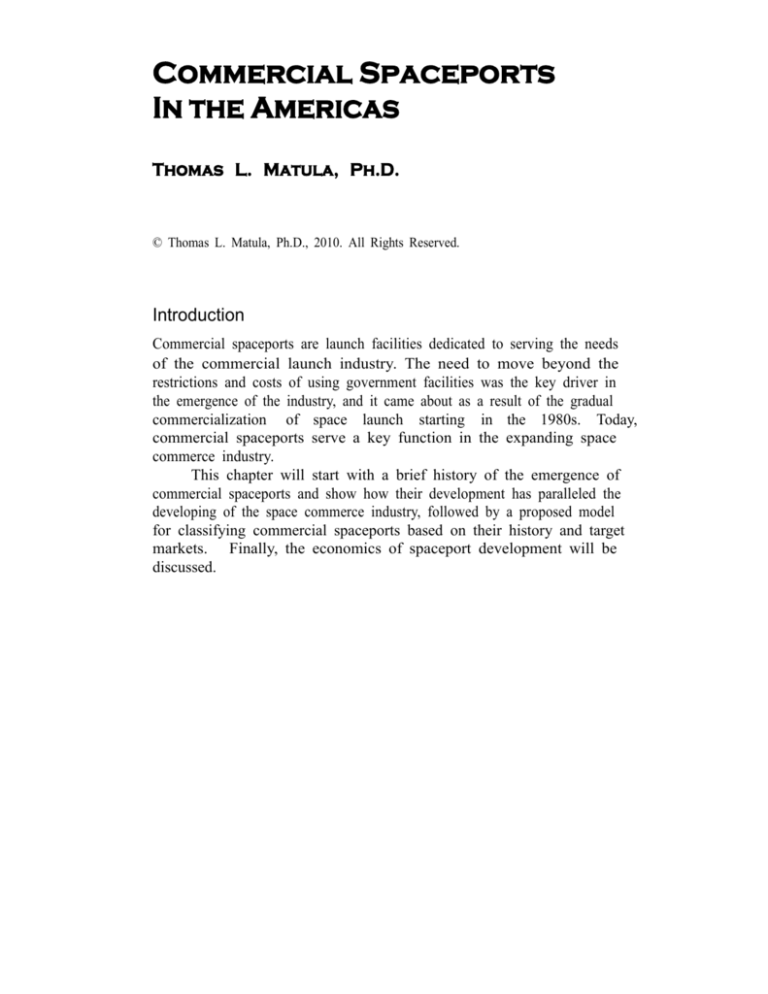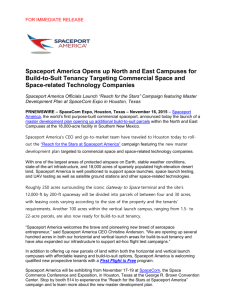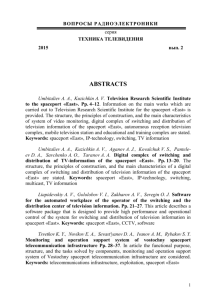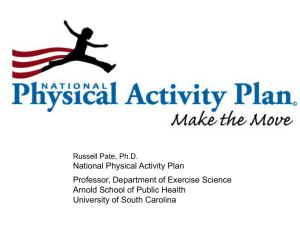
Commercial Spaceports
In the Americas
Thomas L. Matula, Ph.D.
© Thomas L. Matula, Ph.D., 2010. All Rights Reserved.
Introduction
Commercial spaceports are launch facilities dedicated to serving the needs
of the commercial launch industry. The need to move beyond the
restrictions and costs of using government facilities was the key driver in
the emergence of the industry, and it came about as a result of the gradual
commercialization of space launch starting in the 1980s. Today,
commercial spaceports serve a key function in the expanding space
commerce industry.
This chapter will start with a brief history of the emergence of
commercial spaceports and show how their development has paralleled the
developing of the space commerce industry, followed by a proposed model
for classifying commercial spaceports based on their history and target
markets. Finally, the economics of spaceport development will be
discussed.
276
Space Commerce
History
The history of commercial spaceports is most easily divided into three eras.
The Comsat Spaceport Era, the SSTO Spaceport Era and the Suborbital
Spaceport Era. Each era is marked by a different perception of the needs
and requirements of the commercial launch industry. The Comsat
Spaceport Era spans 1979 to 1995 and marks the need for facilities to
launch commercial communication satellites. It was followed by the
optimism of the SSTO Spaceport Era of 1996 to 2002. The Single Stage to
Orbit (SSTO) Spaceport Era started with the proposal for Lockheed’s
proposed SSTO called VentureStar. As part of the VentureStar Project,
Lockheed requested proposals for launch sites, and eighteen states
responded. The third and current era, the Suborbital Spaceport Era, started
with the end of the VentureStar and with it plans for developing SSTO.
Following the end of the SSTO Era, many spaceports refocused their
efforts on the previously ignored suborbital market, stimulated by the
growing interest in suborbital tourism resulting from the X-Prize. This is
the current era and is driving many of the spaceport efforts today.
The Comsat Spaceport Era: 1979-1995
The demand for commercial satellites, especially communication satellites,
created the demand for commercial launch vehicles (Matula and Mitry,
2000). Prior to the 1980s commercial satellites were launched by national
space agencies with a cost reimbursement arrangement (Johnson-Freese
and Handberg 1997). In 1979, the first successful launch of the Ariane
launch system from Guiana Space Centre in French Guiana marked the
beginning of the commercial launch industry. The Ariane was designed
specifically to serve the needs of the commercial satellite industry, which is
why it’s considered the first commercial launch system. This makes the
Guiana Space Centre in French Guiana the first commercial spaceport.
In the United States, commercial satellites continued to be launched
on both expendable launch vehicles like the Delta and Atlas under a cost
reimbursement agreement with NASA. The Space Shuttle was also used
for launching commercial satellites under the same cost reimbursement
arrangement. Following the Challenger accident, commercial payloads
were banned from the Space Shuttle by Executive Order, laying the
foundation for the commercial launch industry in the United States. In
order to accommodate the emerging commercial space launch operations,
several commercial space launch facilities, commonly known as
commercial spaceports, emerged in the 1990s (Johnson-Freese and
Handberg 1997).
In 1989, Spaceport Florida was the first commercial spaceport in the
United States, and was created to serve existing Expendable Launch
The Inside Story
277
Vehicles (ELVs) like the Delta and Atlas that were pressed into service for
the launching of Comsats following the banning of commercial satellite
launches from the Space Shuttle. Spaceport Florida was closely followed
by California Spaceport and the Kodiak Launch Complex in Alaska. The
Spaceports in both California and Alaska were developed to support the
proposed constellations of communication satellites for the satellite mobile
phone markets, but demand failed to meet expectations. Spaceport Florida,
by contrast, was created to serve the market for Geosynchronous
Communication Satellites.
SSTO Spaceport Era: 1996-2002
The Comsat Spaceport Era of commercial spaceports was superseded by
the SSTO Era. It was initiated by the flight tests of the DC-X launch
system in the early 1990s. The DC-X was a sub-scaled prototype of a
Single Stage to Orbit launch system proposed by McDonnell-Douglas.
Although it made only a dozen flights, it stimulated the quest for
development of a SSTO launch system. This resulted in NASA’s X-33 and
X-34 Demonstrator Programs. Lockheed Martin won the competition for
the X-33 Demonstrator with a lifting body SSTO that was intended to be a
sub-scale demonstrator for the VentureStar, a commercial SSTO.
As part of the VentureStar program, Lockheed solicited proposals for
launch sites for the system. Eighteen states responded with plans for
commercial spaceports designed to meet Lockheed’s needs (Matula and
Mitry 2000). Since the VentureStar was a SSTO system, it did not need a
coastal location such as expandable launch vehicles required, but could
actually overfly land areas safely (Matula and Mitry, 2000). As a result,
spaceport proposals were submitted from both existing commercial
spaceports like Spaceport Florida and California Spaceport, and from
inland states including Nevada and Oklahoma, which had no existing
facilities or previous history of space launch.
The most serious efforts were from Montana, Oklahoma and
Washington, which had existing facilities in the form of closed military
bases that would be converted to serve the needs of VentureStar. Some
states went as far as creating state spaceport authorities and funding
detailed business plans. However the failure to complete the X-33
demonstrator vehicle and changes in market demand for space launch
resulted in the VentureStar program being cancelled.
This in turn led to
most of the proposed commercial spaceport projects lapsing into inactivity
and being abandoned due to the lack of any market drivers. However a few
did survive to be reorganized into the next Era, the Suborbital Spaceport
Era.
278
Space Commerce
Sub-Orbital Spaceport Era: 2002 - Present
The end of the SSTO Spaceport Era resulted in a refocus of the surviving
commercial spaceports into a new direction, servicing the emerging
demand for suborbital launch systems. The redirection was most apparent
in the newly proposed spaceports, while the existing ones, Spaceport
Florida, California Spaceport, and Mid-Atlantic Regional Spaceport,
continued their focus on the commercial Expendable Launch Vehicles
(ELVs) that were already using their facilities.
The stimulus for the new direction of commercial spaceports was the
Ansari X Prize (NASA, 2010).
The Ansari X Prize was created to
stimulate the development of suborbital space tourism. The result was an
explosion of proposed suborbital launch systems, which created a demand
for commercial spaceports to serve their needs. Spaceports previously
proposed for the VentureStar system were refocused towards the needs of
suborbital systems, the most prominent among them being New Mexico’s
proposed Southwest Regional Spaceport, the Oklahoma Spaceport, the
proposed Gulf Coast Regional Spaceport, and the Mojave Air and Space
Port.
Burt Rutan and Paul Allen won the Ansari X Prize in 2004 (NASA,
2010). Following their victory, Richard Branson announced that he was
licensing their system for a suborbital tourism spaceline called Virgin
Galactic. (Editor’s note: Please see Chapter 7, A Tourist’s Perspective on
Space.) Shortly after its creation, Virgin Galactic selected New Mexico’s
Southwest Regional Spaceport as the base for its launch operations
(Gomez, et al, 2007). Other suborbital tourism ventures selected other
commercial spaceports. Rocket Plane Kistler selected Oklahoma Spaceport
for its base of operations, although later the venture failed to secure the
financing needed. Blue Origins, another suborbital tourism venture, made
a different choice, and is building its own private spaceport in West Texas.
Although not selected for its operations, Mojave Air and Space Port has
positioned itself well as a research and test facility. Another facility
considered for VentureStar, Cecil Field in Northern Florida has also gone
ahead with licensing as a commercial spaceport.
Spaceport Classification
One challenge when discussing spaceports is the wide range of facilities
that call themselves spaceports, from major existing facilities like
Spaceport Florida to the proposed Spaceport Wisconsin. In this chapter, a
classification system is proposed that is based on the history and
capabilities of the different facilities. The proposed classification system is
based on a two by two matrix, with the horizontal axis based on capability
to support suborbital and/or orbital launches. The vertical axis is based on
The Inside Story
279
the facility’s history: Is it an existing facility that has been converted to
commercial needs, or is it a clear sheet development?
The result is a
simple but practical classification system shown in Figure 1. Examples of
different commercial spaceports are provided in each element of the matrix.
It is not intended to be a comprehensive survey of commercial spaceports
either globally or in the United States.
Suborbital
Orbital
Converted
Facilities
Mojave Air and Space Port Spaceport Florida
Mid-Atlantic Regional Spaceport
Oklahoma Spaceport
California Spaceport
Cecil Field Spaceport
New Start
Facilities
Spaceport America
Blue Origin Spaceport
Spaceport Sheboygan
Guiana Space Centre
Kodiak Launch Complex
Figure 1
Classification of Commercial Spaceports
Converted Suborbital
Converted Suborbital Spaceports are commercial spaceports limited by
location to only suborbital launches. All existing converted suborbital
spaceports started as airfields, either commercial or military, in locations
that enabled them to provide the airspace and facilities needed for
suborbital launch operations. Converted Suborbital commercial spaceports
have the advantage of lower start-up costs since they have existing
infrastructure to use, especially expensive facilities like long runways,
hangers, and associated support buildings. Three examples are highlighted
below.
Mojave Air and Space Port
(http://www.mojaveairport.com/)
Mojave Air and Space Port is located in southern California near
Edwards Air Force Base. The home to Burt Rutan’s Scaled Composite
Corporation, it was the site of the successful test program for
SpaceShipOne, the vehicle that won the Ansari X Prize.
It is currently
home to a flight test program for Virgin Galactic’s SpaceShipTwo, as well
as other entrepreneurial suborbital space ventures. Mojave Air and Space
Port was already an existing commercial airport with an emphasis on pilot
training and flight test operations, and the conversion into a suborbital
facility was a logical extension of those existing aviation activities.
280
Space Commerce
Cecil Field Spaceport
(http://www.cecilfieldspaceport.com/)
Cecil Field Spaceport in located in Jacksonville, Florida at the former
Naval Air Station Cecil Field. Vacated by the U.S. Navy in 1999, Cecil
Field pursued licensing to serve the needs of air launch suborbital systems.
In 2010 it became an FAA licensed spaceport for air launched suborbital
vehicles. Its main advantage is its proximity to the Atlantic Ocean, which
makes it ideal for testing of air-launched suborbital systems.
Spaceport Oklahoma
(http://www.okspaceport.state.ok.us/)
Spaceport Oklahoma, located in Burns, Oklahoma, was originally
Clinton-Sherman Air Force Base, a former U.S. Air Force Strategic Air
Command base. When it was closed in 1969 it was converted into an
industrial park. Its remote location and large runways stimulated interest in
the facility as a site for Lockheed’s VentureStar. After the VentureStar
project was cancelled, the decision was made to use it as a suborbital
launch facility. Rocket Plane Kistler, a suborbital launch venture located
there with the intention to use it as its base of operations. Although Rocket
Plane Kistler went bankrupt in 2010, the field continues to be used by other
suborbital launch ventures.
New Suborbital
New Suborbital spaceports are facilities that are being built from the
ground up at locations with no space launch history. Limited by their
geographic location to suborbital launches, they are focused on the
emerging demand for suborbital launch facilities. New suborbital
commercial spaceports are much more expensive to develop then
Converted Suborbital commercial spaceports because they start with bare
land and few, if any, improvements. This means that all of the necessary
infrastructure, from runways to hangers, must be built new, often an
expensive proposition. This of course creates a much higher barrier to their
development, and has significant consequences for their eventual economic
success.
Spaceport America
(http://www.spaceportamerica.com/)
Spaceport America is located in Upham, New Mexico near the White
Sands Missile Range. Spaceport America originally was started in the
early 1990s as the Southwest Regional Spaceport. The stimulus to its
development was the military’s DC-X program, a subscale prototype of a
Single Stage to Orbital system that was being tested at nearby White Sands
Missile Range. McDonnell Douglas had plans to develop it into a
The Inside Story
281
commercial launch system, and the valley of ranches that Upham, New
Mexico was located in was considered an ideal site.
Following the failure of McDonnell Douglas to win the NASA X-33
competition, the focus of the Southwest Regional Spaceport shifted
towards attracting the winner, Lockheed’s VentureStar. But then with the
cancellation of the VentureStar, Southwest Regional Spaceport shifted its
focus again, this time to the emerging suborbital tourist industry. In 2006 it
was selected as the launch site for Virgin Galactic Space Lines, and actual
construction began. Its name was also changed from the Southwest
Regional Spaceport to Spaceport America. Current plans are to finish the
spaceport in 2010 to support Virgin Galactic launch operations beginning
in 2012.
Figure 1
Illustration showing Spaceport America
Image courtesy of Ad Astra Rocket Company
Blue Origin Spaceport
(http://www.blueorigin.com/)
Blue Origin is a Seattle, Washington based firm that is develop a
private Single Stage to Orbit system based on the original DC-X design.
As part of its program, it has developed its own private spaceport in west
Texas on a cattle ranch just north of the town of Van Horn. Currently the
company is conducting its space launch test program at the site.
282
Space Commerce
Spaceport Sheboygan
(http://www.spaceportsheboygan.org/)
Spaceport Sheboygan is located near Sheboygan Wisconsin on the
shore of Lake Michigan. A number of NASA sounding rockets have been
launched from the site, and the proposed spaceport is being designed to
serve the space educational needs of the Great Lakes region.
Converted Orbital
Convert Orbital commercial spaceports generally have the fewest barriers
to development since they are located at facilities that have already been
launching satellites into orbit for many years. It should be noted that
although these are designated as orbital commercial spaceports, they are
also able to serve the suborbital market as well, which gives them a
competitive advantage in attracting customers. The infrastructure required
for launch operations, from launch pads and runways to tracking and
payload integration facilities, is already in existence, and as a result, the
conversion is largely administrative, with specific pads and facilities turned
over to commercial spaceport for its use. As a result, expenses beyond
administrative and operation costs are usually limited to modifications and
upgrading of the launch pads and payload integration facilities, usually to
meet the needs of specific customers.
Spaceport Florida
(http://www.spaceportflorida.com/)
The oldest commercial spaceport in the United States is located on
the Cape Canaveral Air Force Station, and uses launch pads originally built
for U.S. Air Force needs. Created in 1989 to meet the demand for a
commercial facility to launch payloads on existing systems like Delta and
Atlas, it has developed into the premier spaceport in the United States. The
majority of commercial launches to orbit from the United States are from
Spaceport Florida.
California Spaceport
(http://www.calspace.com/SSI/Welcome.html)
Like Spaceport Florida, California Spaceport is located at an existing
facility for launching orbital vehicles, Vandenberg Air Force Base. It was
created in 1990 to provide a launch site for Expendable Launch Systems
like Atlas and Delta following the banning of commercial payloads on the
Space Shuttle. It is currently the premier location in the United States for
launching commercial satellites into polar and high inclination orbits.
The Inside Story
283
Mid-Atlantic Regional Spaceport
(http://www.marsspaceport.com/)
Developed from NASA Wallops Island launch facility on the coast of
Virginia, the Mid-Atlantic Regional Spaceport, nicknamed MARS due to
its initials, was created to serve the needs of small and medium size launch
vehicles. Since the NASA Wallops Island facility is home to NASA’s
suborbital research program, MARS is also a major player in the suborbital
launch market.
New Orbital
New Orbital commercial spaceports have the biggest barriers to overcome.
Because orbital launches require a large safety area under the launch track,
orbital facilities are usually located on coastal land that is usually highly
desirable for other uses. This usually brings them into conflict with other
potential users, driving up the cost of land. Orbital launch facilities also
require the most infrastructure, from launch pads to extensive launch
tracking systems, and this also increases the cost of their development.
Guiana Space Centre
(http://www.esa.int/esaMI/Launchers_Europe_s_Spaceport/)
The Guiana Space Centre is located near Kourou in French Guiana in
South America. It was constructed in the late 1970’s by the European
Space Agency (ESA) specifically to serve the needs of the Ariane launch
system. Since the Ariane launch family was designed to meet the needs of
the commercial communications satellite industry it has a strong claim to
being the first commercial spaceport, although it is still owned by the
European Space Agency.
Kodiak Launch Complex
(http://www.akaerospace.com/)
The Kodiak Launch Complex is located on Kodiak Island in the Gulf
of Alaska. It is owned and operated by the Alaska Aerospace Corporation,
which is in turn owned by the state of Alaska. It was developed in the
1990s to serve the needs of the emerging satellite mobile phone market.
Satellites for these mobile phone systems required high inclination and
polar orbits, making a high latitude site like Kodiak Island ideal for
launching them. However the collapse of the satellite mobile phone
industry eliminated the original target market for the Kodiak Launch
Complex. Since then it has only served a limited number of suborbital
launches for the Department of Defense related to testing systems for
missile defense.
284
Space Commerce
Commercial Spaceports and Economic Development
There are two major differences between commercial spaceports and
traditional government and military spaceports. The first is that like
seaports and airports, spaceports are seen as a tool to attract economic
activity to a region, and thus the driving factor behind most commercial
spaceports is the desire to stimulate local economic development. By
contrast, traditional government launch facilities are focused on simply
meeting the need for access to space for the programs that fund them.
The second major difference is funding.
Traditional government
spaceports are funded as part of the programs they serve, while commercial
spaceports are expected to be self-funding from the revenue streams they
create. The underlying problem is that the revenue models generally used
for airports and seaports will not work for commercial spaceports (Matula
and Mitry, 2002).
The revenue streams from commercial airports and seaports are a
result of the high volume of traffic that moves through them on daily basis.
The typical commercial airport will see many flights a day, with thousands
or even millions of passengers a year, not to mention hundreds of
thousands of pounds of airfreight. Similarly, active seaports see hundreds
of thousand of tons of cargo in a typical year.
(Editor’s note: See Chapter 16, A Space Commercialization Model: Ocean
Ports and Inter-Modal Transportation.)
In contrast, a commercial spaceport is considered busy if there are
more then a dozen launches a year.
These key differences have had a major impact on the commercial
spaceport industry. Although commercial spaceports have been around for
many years, few have achieved the desired level of economic success.
Like the commercial launch industry, the commercial spaceport industry
has left a trail of failed projects and failed ventures, and a key factor has
been that the projected drivers of demand, often used in the business plans
of commercial spaceports, and typically high volumes of satellite launches
or high volumes of suborbital tourism, have failed to develop on the
timelines expected by the developers of the spaceports.
Another factor is the relatively small size of the launch industry, with
few firms or launch systems. The long lead times and high development
costs for new systems, combined with a lack of demand, have created
major barriers to profitability, in fact even breaking even is a challenge for
commercial spaceports.
This is why Matula and Mitry (2002) have argued that a new
business model is needed for commercial spaceports, a model designed
around their economic assets and less dependent on demand for launch
services.
The Inside Story
285
We suggest that the key economic assets of a spaceport are:
Large land area for use as a safety zone.
Advanced telecommunication infrastructure.
Storage and handling facilities for cryogenic gases and other
chemicals used in launch operations.
A runway capable of handling commercial jets and controlled
airspace.
A
skilled technical workforce.
Access to educational and research institutions.
The key to developing commercial spaceports is therefore to leverage
these assets to attract complementary business activities, which then create
additional revenue streams (Matula and Mitry, 2002). Examples include
alternative energy research, explosives research, rocket engine research,
security training, flight testing, ecotourism, biotech research,
manufacturing, agricultural research, and educational activities.
All would have the potential to generate significant revenues in the
near term while the launch traffic models develop as space commerce
industry itself matures and demand increases. In addition, activities such as
biotech, rocket engine development and education have the potential to add
to the launch traffic for the facility. The key point that Matula and Mitry
(2002) make is that developers of commercial spaceports must cast a wide
net to attract complementary business and economic activities to drive the
development of any spaceport facility.
Summary
Commercial spaceports emerged with the demand for commercial launch
services, with the first facilities appearing in the 1980s. Since then, many of
commercial spaceports have been developed. The most successful have
been facilities like Spaceport Florida and California Spaceport, which were
based on existing launch infrastructure and demand. New start commercial
spaceports have had a much more difficult challenge due both to higher
costs of development and the need to create new demand. Although some,
like the Guiana Space Centre and Spaceport America, have overcome these
difficulties through the strong government support, ultimately the long term
success of the commercial spaceport industry will be dependent on the
creation of new demand for commercial launch services.
•••
286
Space Commerce
Thomas L. Matula, Ph.D.
Dr. Matula has a Bachelors degree from the New Mexico
Institute of Mining and Technology (1983) and both an
MBA degree (1984) and Ph.D. in Business Administration
from New Mexico State University (1994). His dissertation
focused on development of a model designed to identify
factors that would influence public support for commercial
spaceports. He since has published numerous articles on
space policy and economic development strategies for the
space industry. Dr. Matula has served on the American
Society of Civil Engineer’s Space Engineering and Construction Committee
and its Subcommittee on Space Education Initiatives. His academic career
includes over twenty years of teaching and research on business strategy and
marketing.
References
Johnson-Freese, J., and Handberg, R. (1997), Space: The Dormant Frontier:
Changing the Paradigm for the 21st century, Praeger.
Cecil Field Spaceport (2010). “Cecil Field Spaceport”, Retrieved from
http://www.cecilfieldspaceport.com/ on July 31, 2010.
Gomez, Lou, Bill Gutman, Burton Lee, Bernie McCune. (2007). “History of
Spaceport America”, Retrieved from
http://spacegrant.nmsu.edu/isps/presentation/history.pdf on July 31, 2010.
Matula, Thomas L., and Darryl J. Mitry (2000), "Public Attitudes Toward
Overland Rocket Flight," in the Proceedings of Space 2000: The 7th
International Conference on Engineering, Construction, and Operations in
Space, Albuquerque, NM, Feb. 27 - March 2, 2000. 160-166
Matula, Thomas L and Darryl J. Mitry (2002), "Spaceports as Multi-use
Industrial Facilities – A Marketing Approach," in the Proceedings of Space
2002: The 8th International Conference on Engineering, Construction, and
Operations in Space, Albuquerque, NM, March 14-17, 2002. 135-141
NASA, (2010). “Ansari X Prize : A Brief History and Background.” Retrieved
from http://history.nasa.gov/x-prize.htm on July 31, 2010.
(Editor’s note: Please see the following Chapter 18, A New European
Spaceport: Law and Politics in Spain for a discussion of a European
perspective, with a focus on the underlying legal issues.)










